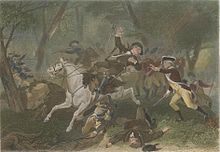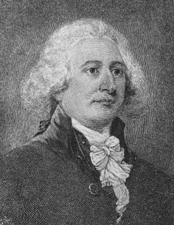| |||||
| Decades: | |||||
|---|---|---|---|---|---|
| See also: | |||||
| 1780 in the United States |
| 1780 in U.S. states |
|---|
| States |
| List of years in the United States by state or territory |
Events from the year 1780 in the United States.
| |||||
| Decades: | |||||
|---|---|---|---|---|---|
| See also: | |||||
| 1780 in the United States |
| 1780 in U.S. states |
|---|
| States |
| List of years in the United States by state or territory |
Events from the year 1780 in the United States.




The 1770s was a decade of the Gregorian calendar that began on January 1, 1770, and ended on December 31, 1779. A period full of discoveries, breakthroughs happened in all walks of life, as what emerged at this period brought life to most innovations we know today.

1780 (MDCCLXXX) was a leap year starting on Saturday of the Gregorian calendar and a leap year starting on Wednesday of the Julian calendar, the 1780th year of the Common Era (CE) and Anno Domini (AD) designations, the 780th year of the 2nd millennium, the 80th year of the 18th century, and the 1st year of the 1780s decade. As of the start of 1780, the Gregorian calendar was 11 days ahead of the Julian calendar, which remained in localized use until 1923.

1778 (MDCCLXXVIII) was a common year starting on Thursday of the Gregorian calendar and a common year starting on Monday of the Julian calendar, the 1778th year of the Common Era (CE) and Anno Domini (AD) designations, the 778th year of the 2nd millennium, the 78th year of the 18th century, and the 9th year of the 1770s decade. As of the start of 1778, the Gregorian calendar was 11 days ahead of the Julian calendar, which remained in localized use until 1923.

John Trumbull was an American painter and military officer best known for his historical paintings of the American Revolutionary War, of which he was a veteran. He has been called the "Painter of the Revolution". Trumbull's Declaration of Independence (1817), one of his four paintings that hang in the United States Capitol rotunda, is used on the reverse of the current United States two-dollar bill.

John Brown was an American lawyer and statesman who participated in the development and formation of the State of Kentucky after the American Revolutionary War.

Benjamin Tallmadge was an American military officer, spymaster, and politician. He is best known for his service as an officer in the Continental Army during the American Revolutionary War. He acted as leader of the Culper Ring during the war, a celebrated network of spies in New York where major British forces were based. He also led a successful raid across Long Island that culminated in the Battle of Fort St. George. After the war, Tallmadge was elected to the US House of Representatives as a member of the Federalist Party.

1776 (MDCCLXXVI) was a leap year starting on Monday of the Gregorian calendar and a leap year starting on Friday of the Julian calendar, the 1776th year of the Common Era (CE) and Anno Domini (AD) designations, the 776th year of the 2nd millennium, the 76th year of the 18th century, and the 7th year of the 1770s decade. As of the start of 1776, the Gregorian calendar was 11 days ahead of the Julian calendar, which remained in localized use until 1923.
Conway-Johnson family was a prominent American political family from Arkansas of British origin. It was founded by Henry Wharton Conway of Greene County, Tennessee, who had come to the state of Arkansas in 1820 with his younger brother James and his cousins Elias and Wharton Rector, all of whom were deputy-surveyors under the patronage of their uncle, William Rector, Surveyor General of Missouri, Illinois, and Arkansas.

1776 is celebrated in the United States as the official beginning of the nation, with the Declaration of Independence of the Thirteen Colonies from the British Empire issued on July 4.

Events from the year 1777 in the United States.
Events from the year 1778 in the United States.
Events from the year 1779 in the United States.
Events from the year 1782 in the United States

Events from the year 1783 in the United States. The American Revolution officially ended with the Treaty of Paris.
Events from the year 1786 in the United States.
Events from the year 1787 in the United States. The United States Constitution was written and the ratification process began.
Events from the year 1789 in the United States. The Articles of Confederation, the agreement under which the nation's government had been operating since 1781, was superseded by the Constitution in March of this year.
Events from the year 1790 in the United States.